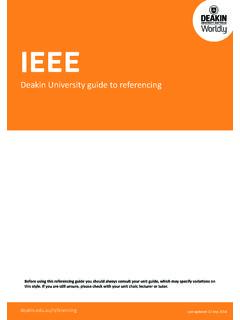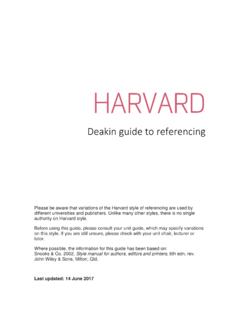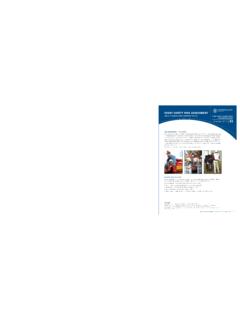Transcription of Conducting Observational Research - Deakin University
1 Conducting Observational ResearchAssociate Prof. Melanie BryantSwinburne Business SchoolOverview of the workshop The what's, aims and benefits of observation Methodological considerations Observation as a method Ethical considerations Observation templates Developing field notes Analysing and writing about Observational data Evaluating quality Plenty of time for discussion and questionsWhere do observations fit into a broader Research design? Research question(s) Paradigmatic approach Ontology Epistemology Theoretical perspective Methodology Information about the sample/participants Method(s) of data collection Method(s) of data analysisWhat is going on here?What is observation? Observationis a method of data collection in which researchers observe within a specific Research field. It is sometimes referred to as an unobtrusive method Participant observation involves the observer being a member of the setting in which they are collecting data there are quite a few variations of this definition Observation is normally associated with an ethnographic methodology (more later) but can be used as part of other Research designs All of the above seek to find out what is going on here?
2 The value of observation The Research is better able to understand and capture the context within which people interact Firsthand experience with a setting allows researchers to open to discovery and inductive, rather than guessing what the context is like The Research may see things that routinely escape awareness of the participant using a different method It provides a chance to learn things that people may be unwilling to discuss in an interviewAims of Observational research1. Seeing through the eyes events, actions, norms, values etc from the perspectiveof the people being studied2. DescriptionAttendingto mundane detail to help us understand what is going on and to provide clues to other layers of reality3. ContextualisationWhatever the sphere inwhich the data are being collected, we can only understand events when they are situated in the wider social and historical context4. ProcessViewing social life as a seriesof interlocking events5. Flexible researchA preference for semi or unstructured Research design, rather than imposing prior frames of reference onto the study6.
3 Avoiding early use of theoriesand conceptsRejects premature attempts to impose theoriesand concepts which may exhibit poor fit with participants perspectivesSource: Bryman (1988: 61-2); Silverman (2008)Methodological principals Jones et al (2006)Key featuresObjectivismConstructionismSubjec tivismLinked to positivistapproachesLinked to interpretivism, constructivism, post-structuralism)Linked to critical theoryThe purposeof the researchTo explain and predict Research should be generalizable; there is an objective truthindependent of the researcherTo understandcomplex human phenomena To question accepted knowledge and shed light on social injustice so that change can occurRole of researcherTranslatorInterpreterEngagedad vocateRelationshipbetween researcher and participantShouldbe objective: distance and detachment from participantNot possible to beobjective, researcher is a co-constructor and shares relationship with participantObjectivityharmful researcher s position needs to be made clear in terms of how it influences the Research and can lead to changeResearch truths Truth can be obtainedthrough rigorous researchTruthis co-constructed, or truth may be considered to not existConcept of truth unlikely to exist,meaning shifts over timeEthnography v observation Ethnography is a methodology developed for the study of cultures and cultural sense-making Derived from anthropology Is normally linked to inductive Research a focus on local interpretations Aimed at understanding an insider sperspective: habits, norms, practices, rituals, patterns of interaction, rituals Can be designed from different epistemological approaches , critical, interpretivist, postmodernist etc.
4 Can include auto-ethnography or performance ethnography Ethnography involves observation, but not all observation has to be ethnographicAn example of ethnography principles Angrosino (2005) makes two important methodological distinctions: Objectivist approach to ethnography/observation Related to positivist Research Researchers claim that they are able to maintain objectivity and that they do not influence, interfere with people or activities under observation They adhere to strict rules of rigour that prevent researchers biasing the data To not do so would involve going native the data was be rendered suspect Postmodernist approach to ethnography/observation Related to approaches such as social constructionism etc Researchers influence and affect the Research setting and are very much a part of this An extra pair of hands Observational objectivity is neither feasible nor desirable the researcher is part of the production of knowledge Regardless, we should acknowledge the Hawthorne Effect created by researchers when Conducting observationAn example of a Research design using observationResearch do members of operating teams interact and communicate?
5 Contributes to the communication climates in different operating theatres? interprofessional values exist in theatre teams. If so, how do they impact on the behaviour and interactions of operating theatre team members? Research site: operating theatres in general, vascular and orthopaedic surgery; compare one metropolitan and one regional hospital siteParticipants: surgeons, registrars, nursing staff (scrub, scout and anaesthetic), team leaders, theatre technicians, patientsOther key personnel: Director of clinical services; director of medical services; theatre manager; patient admissions manager; admissions staff; team leaders of each theatreOntology: Social constructionistEpistemology: Interpretivist Methodology: EthnographyMethods of data collection: (approximately 40 hours in theatre across the two sites); memo s conversations with staff in the theatre and/or theatre suite ( Change rooms, staff room, corridors etc) semi-structured interviews to follow up and clarify findings from observations (include questions about medical jargon, differences in procedure amongst team leaders etc)Data analysis: coding of observation notes.
6 Field notes (which includes details of informal conversations with staff; analytic memos; recording of personal experiences, context); thematic analysisResearch team: Myself (organisational behaviourist); A (sociologist); S (sociologist); E (epidemiologist). Key points to consider when using observation as a method Is it compatible with your Research aims, questions and paradigmatic approach? How will it add value to your Research in addition to or in place of other methods? Are there any ethical, access or other issues that might make observations difficult? How will you collect Observational data? Structured template, unstructured, semi-structured? How will you organise your field notes, personal notes etc? Will other data methods be used? If so, how will they add value? If you are seeking to triangulate, how will this be compatible with epistemology etc?Ethical issues in ethnography/observation Ethical issues are not dissimilar from other forms of qualitative Informed consent of all involved Guarantee of anonymity Giving back to the Research site.
7 But there are some additional issues we should be aware of We commit ourselves to long-term relationships Trust is a very important issue We will see and hear things of a sensitive nature We may become a sounding board for others Van Maanen (1988) describes us as part spy, part voyeur, part fan, part member Practice your own observation Part observationFind a spot nearby where you can conduct a 10 minute uninterrupted observation. As part of this activity, note down what is happening in your location including: What is happening within the location Ambience, atmosphere, environment Physical characteristics of the setting How you are feeling and how you think this might influence what you are observing and recording The aim of the activity is to develop a set of notes that describe the scene as much as do we look for when doing observation? Observations have to be tied to the Research question(s), which should act as a guide Observations can be unstructured, semi-structured or structured.
8 Semi-structured and structured involve the development of an observation template. Observations should normally have some structure but not to the point that we are locked in to a particular theoretical approach Unstructured observation can be a waste of time if we are time poor but we also need to allow for other things to emerge from the data Piloting data collection is an important way of determining what is important to include or what could possibly be ignored Allow data to emerge through the process field notes towards the end of data collection might look very different from field notes at the startWhat do we look for in observation? What is your role in the setting? Are you a background observer , an extra pair of hands, or a participant? Should you develop a set of notes away from the observation setting? Some things to consider - Context: What does the site look like? Smell like? Feel like? How is it set up physically? Take note of this for richness of data Draw the site or take a photo (ethics permitting) this will jog your memory later and can be used as part of the data Consider the following do you see and how these photos make you feel?
9 Do you have prior knowledge or experience? How does our background influence the way we see this? (important for reflexivity if you are using more interpretive approaches)What do we look for in observation? Are there certain aspects of the site that you find physically distracting? If so, how do these effect your data collection? Are there aspects that you find psychological or physiologically distracting? How do these effect your data collection? What is happening when nothing seems to be happening? How do I collect data without affecting the Research setting too much? Or does it matter? Am I learning from being involved in interactions in the setting? In observations, our data comes predominantly from field notesField notes Silverman highlights a number of different questions we should consider when Conducting observations and writing field are people doing? What are they trying to accomplish? exactly do they do this? do people characterise and understand what is going on?
10 Assumptions do they make? questions: What do I see going on here? What did I learn from these notes? Why did I include them? Other things to consider: What else is happening in this site that is relevant to my Research question(s)? How do I feel collecting this data? Comfortable, imposter etc how will this affect the data (reflexivity)? If you are not sure whether you should record it, record it anyway it s better to have too much than not enough. What do I do with my data now that it s collected?Practice your own observation Part observationBased on the unstructured observation, develop a specific Research question about the location. Now repeat the observation for a 10 minute period but only noting data that refers specifically to your Research part of this exercise, consider the issues we have discussed in terms of what to look for and how to write field what do we do? Observational data should be analysed as appropriate to your overall analytical strategy.











